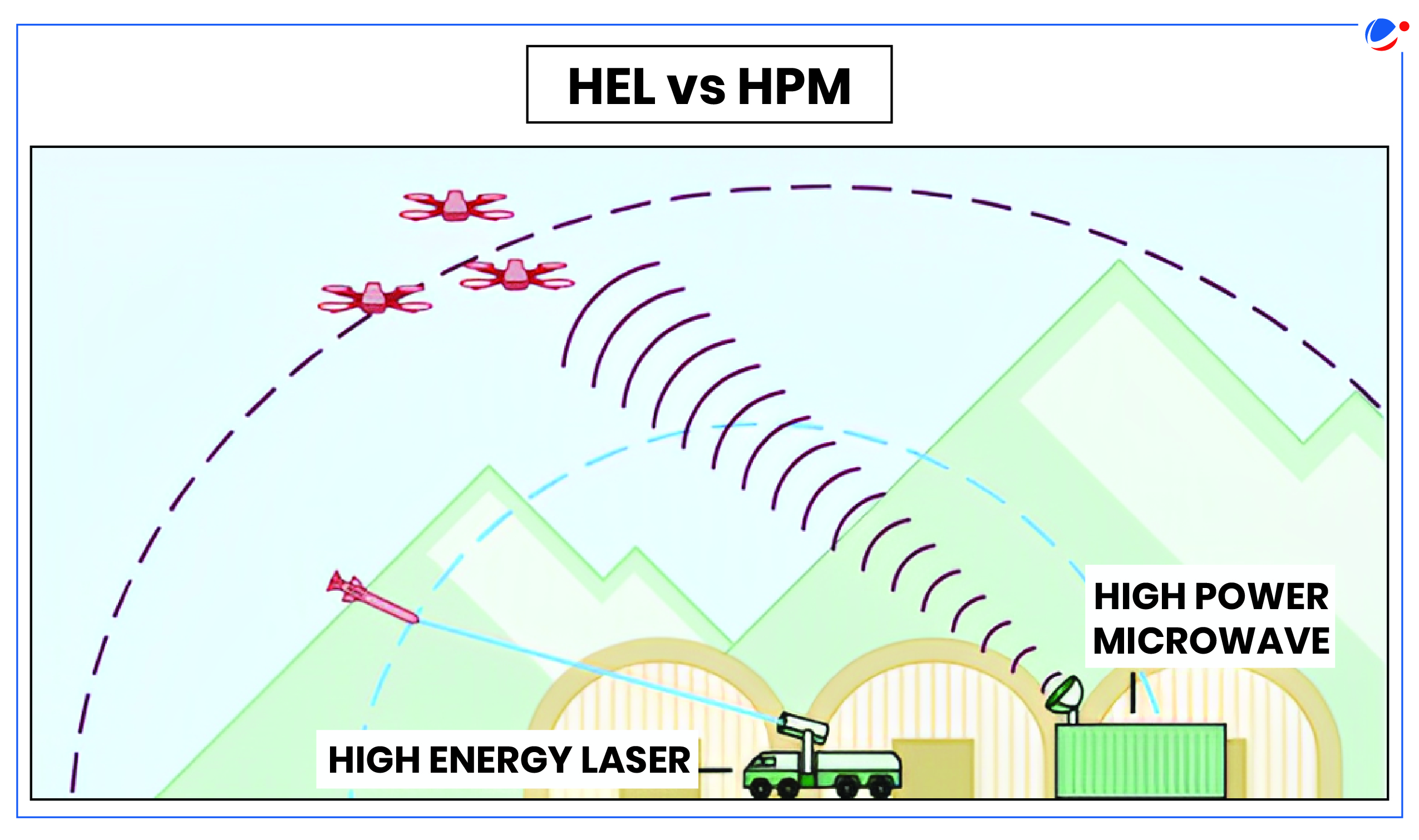Why in the news?
Recently, significant investments have been made by India in the field of Directed Energy Weapons.
About Directed Energy Weapons (DEWs)
- DEWs are ranged weapons that use concentrated energy from electromagnetic or particle technology, rather than kinetic energy, to incapacitate, damage, disable or destroy enemy equipment, facilities, and/or personnel.
- DEWs expand the range of electronic warfare.
- Electronic warfare includes any strategic use of the electromagnetic spectrum against an enemy in a military conflict.
- How do DEWs Work?
- DEWs emit electromagnetic energy at the speed of light, using different regions of the electromagnetic spectrum to penetrate various materials based on their wavelength.
- Their power output is significantly higher than everyday devices (like household microwaves), enabling them to disrupt or destroy targets effectively.
- Applications of DEWs
- Military Defense: To intercept and destroy incoming missiles, neutralize drones, and disable enemy electronics.
- Law Enforcement and Border Security: Non-lethal DEWs e.g. microwaves or lasers can be used for crowd control and border security.
- Space Operations: To protect satellites from debris and anti-satellite weapons.
Types of Directed Energy Weapons
|
Advantages of DEWs
- Cost efficiency per shot: Compared to traditional munitions, DEWs are potentially less costly per shot than missiles.
- E.g., Britain's DEW 'DragonFire' laser, which was successfully test fired recently, is reportedly able to shoot down enemy aircrafts/missiles at a per-shot cost of less than £10.
- Rapid response time: The speed of light in a laser beam enables near-instantaneous reach to a target, a critical factor in countering fast-moving threats.
- It eliminates the need for calculating intercept courses as required for interceptor missiles,
- Logistical efficiency: They eliminate the need for traditional (physical) ammunition and mechanical loading, relying instead on a power source, which can simplify supply chains.
- Precision: Light and other forms of directed energy are unaffected by gravity, wind, or Coriolis force, allowing for highly accurate targeting.
- Stealth: Many DEWs operate silently and invisibly, especially those outside the visible spectrum, making them difficult to detect.
- Countering Low-cost drones and rockets: DEWs can target large volumes of cheap unmanned systems and munitions, which can overwhelm current air and missile defences.
Challenges of DEWs
- Technological limitations: DEWs are generally less effective the farther they are from the target, and atmospheric conditions and cooling requirements can limit their effectiveness.
- E.g., fog and storms can reduce laser beam range and quality.
- Battlefield use: Decisions about how and when to use DEWs may be challenging.
- E.g., wider beam DEWs such as high-power microwave or millimeter wave weapons, affect all assets in an area, whether friend or foe.
- Ethical and health concerns: Uncertainty around DEWs' long-term health effects on people (either intentionally or unintentionally exposed to directed energy) has raised ethical questions about their use.
- Arms race: Development of DEWs by one government can trigger an arms competition among other nations, escalating tensions.
- Other concerns:
- Currently, DEWs are comparatively large and need substantial energy for their operation.
- High costs associated with the research and development of DEWs.
- Need for HELs to have a clear line of sight to the target.
- Reflective materials and other countermeasures can be employed to mitigate the effectiveness of DEWs.
Steps taken by India for DEWs
- Directionally Unrestricted Ray-Gun Array (DURGA)-II Project: Initiated by Defence Research Development Organization (DRDO) to build 100-kilowatt lightweight DEW.
- 2kW DEW System: Developed by Bharat electronic limited for countering new threats like drones and Unmanned Aerial Systems.
- Laser Science and Technology Centre (LASTEC): Laboratory of DRDO developing direct energy weapons, called project Tri-Netra.
- Kilo Ampere Linear Injector (KALI): It is a linear electron accelerator for targeting long-range missiles being developed by DRDO and the Bhabha Atomic Research Centre (BARC) .
Examples of DEWs across the globe
|
Conclusion
Given the persistent threat posed by its neighbours, particularly China and its vast technological prowess, India's defence needs to be prepared to deal with the inevitable threat posed by both autonomous and hypersonic weapons, with DEWs as a potential solution.




